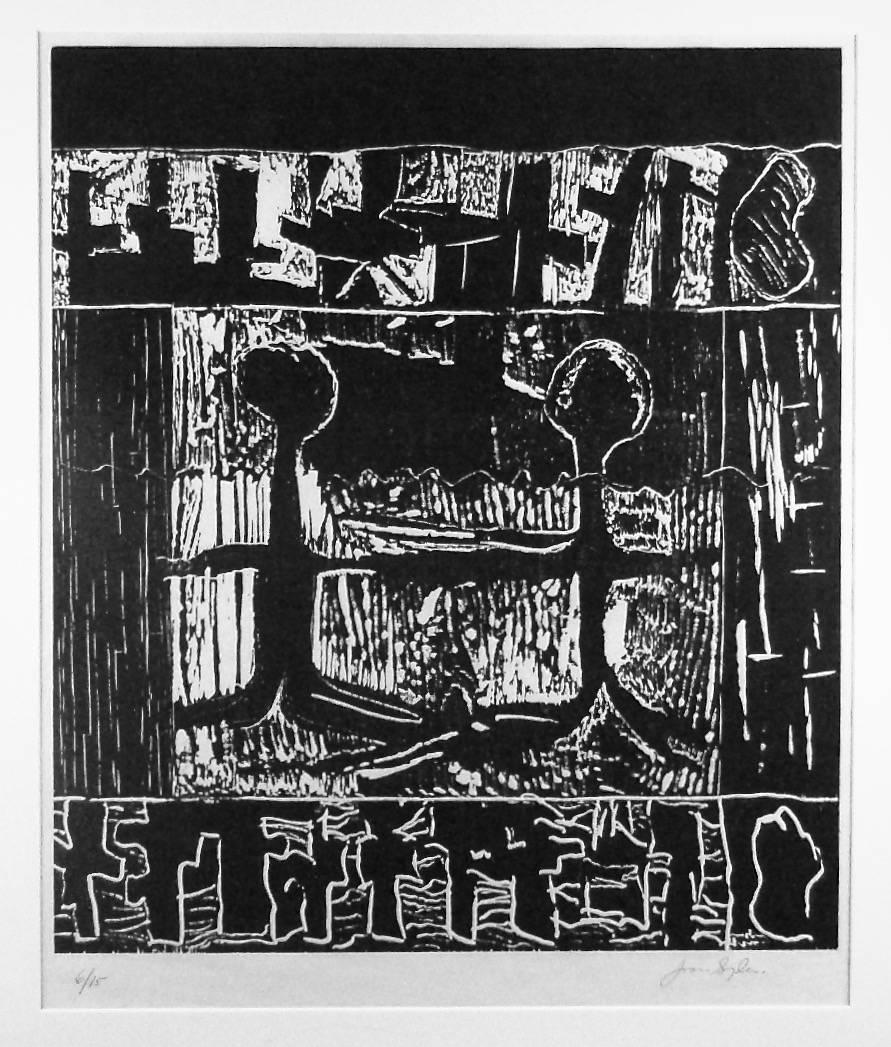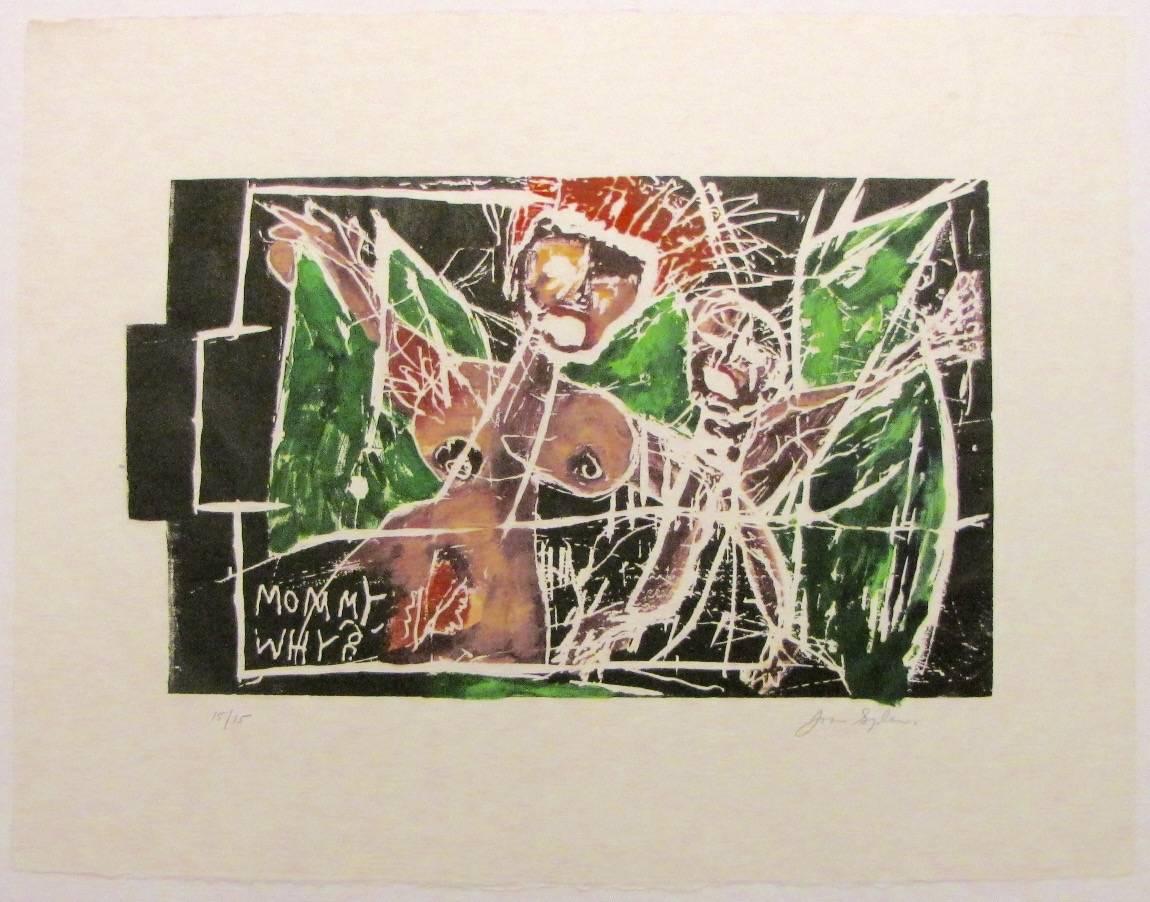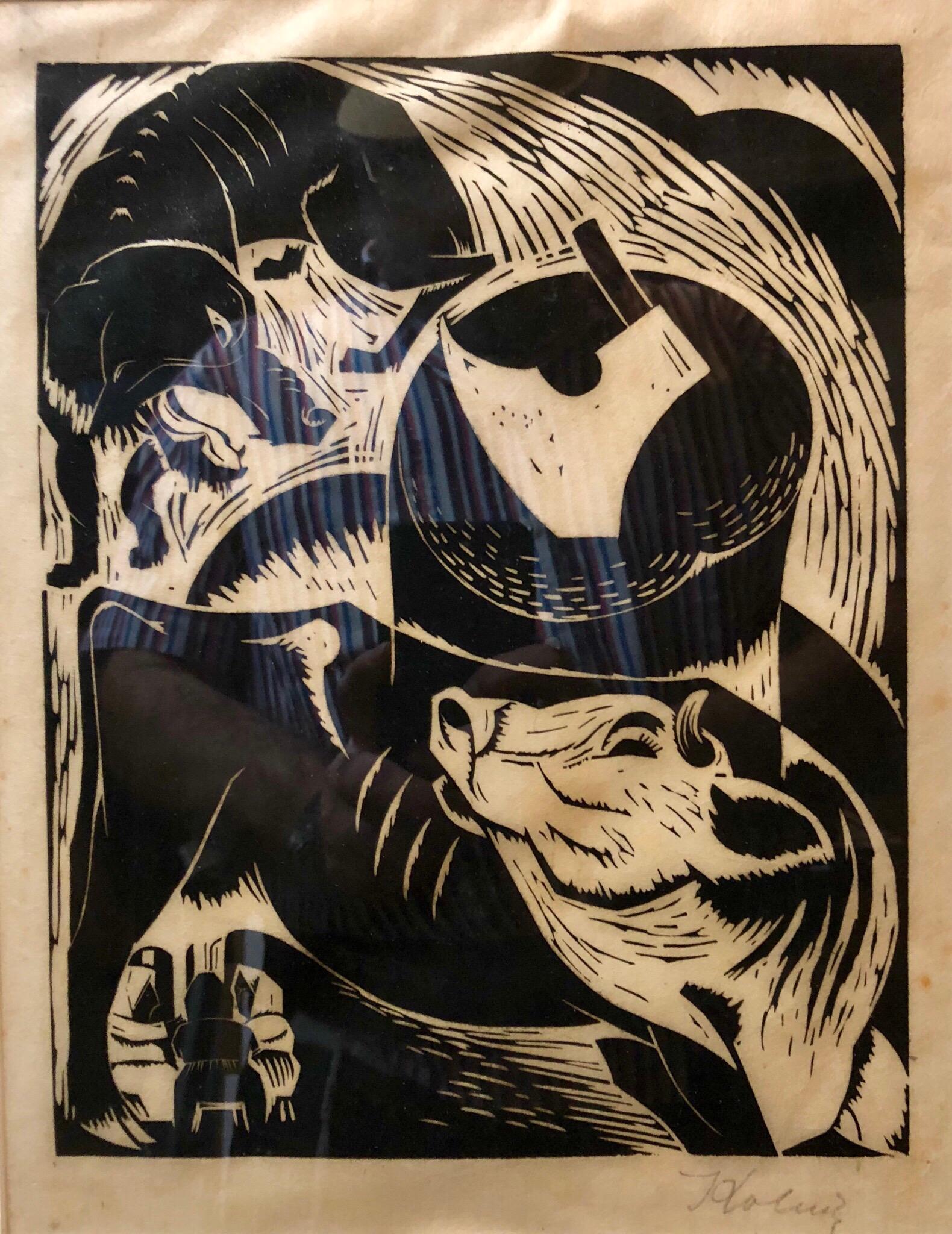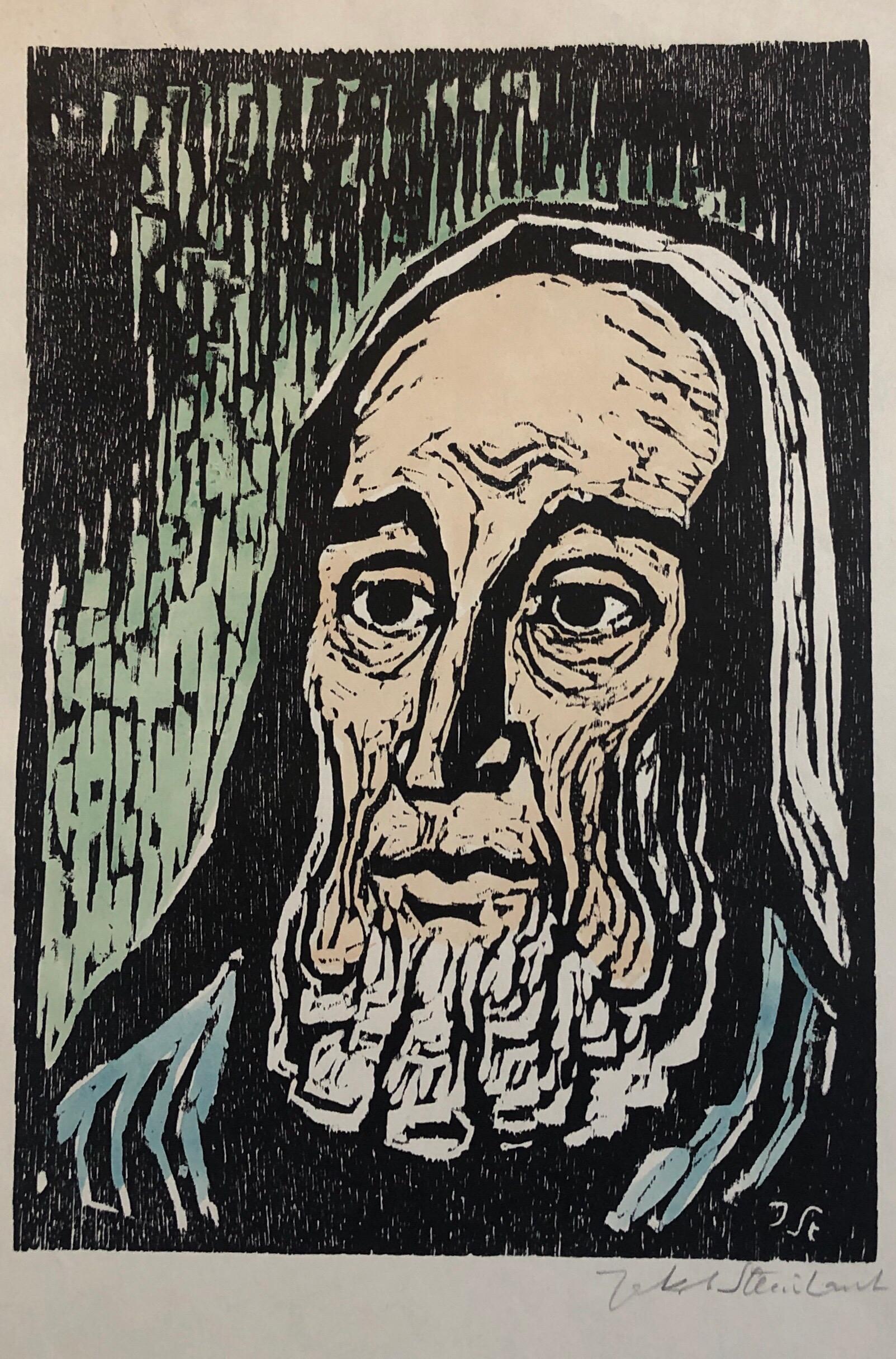Items Similar to Jacob Steinhardt Woodcut Print "Rachel Weeping For Her Children" Signed Numbered
Want more images or videos?
Request additional images or videos from the seller
1 of 11
Jacob SteinhardtJacob Steinhardt Woodcut Print "Rachel Weeping For Her Children" Signed Numbered1962
1962
About the Item
“A voice is heard in Ramah, mourning and great weeping, Rachel weeping for her children and refusing to be comforted, because they are no more.” This verse from Jeremiah 31:15 is the subject of this woodcut print by Jacob Steinhardt, depicting Rachel, who was the mother of the tribes of Joshua and Benjamin, and who was the wife of Jacob who was Israel, weeping for her children which is to be understood as after the destruction of the First Temple in Jerusalem, the Israelites were clustered into Ramah, the home of the Benjaminites, before being taken into the Babylonian captivity; Rachel is weeping for the destruction and expulsion of her descendants. This work is exemplary of the Jewish themes of Jacob Steinhardt, a German Jew who left the country after the rise of the National Socialists and settled in the Palestinian Mandate, which became Israel. This piece is numbered 66 from the edition of 100, signed in pencil in the lower left. It is signed in pencil lower right: "J. Steinhardt". Matte is 18.66 x 13 inches, print is 15.75 x 10 inches.
Jacob Steinhardt was born in Zerkow, Germany in 1887 and in 1906 studied at the School of Art in Berlin where he studied with Lovis Corinth and Hermann Struck and also joined the Berlin Secession movement--a movement that revolted against the artistic restrictions of the Kaiser--as well as founding the Pathetiker Group. He moved to Paris on 1908 and became colleagues with Theophile Steinlen and Henri Matisse. During WWI he patriotically served his country by enlisting in the German army. After Hitler came to power in 1933 he sensed the change that was coming in Germany and left for the Palestinian Mandate to join the Zionist project for a Jewish state that would be a safe haven for Jews was currently underway. After moving to Palestine, he joined the Bezalel school group and opened his own art school. He died in 1968, spending over three decades in the land that would become the State of Israel and helping to building its nascent art movement.
Photos by PD Rearick
- Creator:Jacob Steinhardt (1887 - 1968, Israeli)
- Creation Year:1962
- Dimensions:Height: 19.75 in (50.17 cm)Width: 14 in (35.56 cm)
- Medium:
- Movement & Style:
- Period:
- Condition:
- Gallery Location:Detroit, MI
- Reference Number:1stDibs: LU128618638422
About the Seller
5.0
Vetted Seller
These experienced sellers undergo a comprehensive evaluation by our team of in-house experts.
Established in 2014
1stDibs seller since 2019
95 sales on 1stDibs
Typical response time: 4 hours
- ShippingRetrieving quote...Ships From: Detroit, MI
- Return PolicyA return for this item may be initiated within 14 days of delivery.
More From This SellerView All
- Max Weber Woodcut Print from "Primitives" Poetry Book SignedBy Max WeberLocated in Detroit, MIONE WEEK ONLY SALE This woodcut print is an expressionist print on one of the poems from Max Weber's poetry collection "Primitives: Poems and Woodcuts". This work is signed in penci...Category
1920s Expressionist Figurative Prints
MaterialsWoodcut
- "History of Detroit" Linoleum Cut, Black Ink, African American, Mural StyleBy Hubert MasseyLocated in Detroit, MI"History of Detroit" is in the style of a mural by the master muralist from the city of Detroit, Hubert Massey. It renders in dramatic composition the ov...Category
Early 2000s American Modern Figurative Prints
MaterialsLinocut
- Arnold Singer "Woman on Arm of Sofa" Lithograph Linear Black & WhiteLocated in Detroit, MI“Woman on Arm of Sofa” is an extraordinary lithograph by Arnold Singer. You could say it is representative of his interests in several art styles that ar...Category
1960s Contemporary Figurative Prints
MaterialsLithograph
- Axel Crieger Audrey Hepburn Fotocollage Print "Fragility Adored" Ltd EdBy Axel CriegerLocated in Detroit, MISALE ONE WEEK ONLY "Fragility Adored" a Fotocollage print on photographic paper by Axel Crieger (1955 - ) of an Audrey Hepburn publicity photo for "Sabrina" now placed in a cafe. I...Category
1950s Conceptual Figurative Prints
MaterialsPhotographic Paper
- Roy Lichtenstein Tryptich "as I opened fire" 1966 Stedelijk Museum AmsterdBy Roy LichtensteinLocated in Detroit, MISALE ONE WEEK ONLY "As I opened fire" is a lithograph triptych by Roy Lichtenstein whose provenance is printed on verso: Coll. Stedelijk Museum Amsterdam. Editions were copyrighted by the Stedelijk Museum Amsterdam and corrected with the original and printed in the Netherlands. Each piece measures: 25 1/8" h x 20 5/8" w. Roy Fox Lichtenstein was an American pop artist. During the 1960s through the 90’s, along with Andy Warhol, Jasper Johns, and James Rosenquist, he became a leading figure in the new art movement. His work defined the premise of pop art through parody. Most of Lichtenstein's best-known works are relatively close, but not exact, copies of comic book panels, a subject he largely abandoned in 1965. Lichtenstein's Still Life paintings, sculptures and drawings, which span from 1972 through the early 1980s, cover a variety of motifs and themes, including the most traditional such as fruit, flowers, and vases. Inspired by the comic strip, Lichtenstein produced precise compositions that documented while they parodied, often in a tongue-in cheek manner. His work was influenced by popular advertising and the comic book style. His artwork was considered to be "disruptive". He described pop art as "not 'American' painting but actually industrial painting". His paintings were exhibited at the Leo Castelli Gallery in New York City. Wham!, and Drowning Girl Look Mickey proved to be his most influential works. His most expensive piece is Masterpiece which was sold for $165 million in January 2017. Lichtenstein received both his Bachelors and Masters at Ohio State University, Columbus, Ohio where he taught for ten years. In 1967, he moved back to upstate New York and began teaching again. It was at this time that he adopted the Abstract Expressionist style, being a late convert to this style of painting. Lichtenstein began teaching in upstate New York at the State University of New York at Oswego in 1958. About this time, he began to incorporate hidden images of cartoon characters such as Mickey Mouse and Bugs Bunny into is abstract works. In 1960, he started teaching atRutgers University where he was heavily influenced by Allan Kaprow, who was also a teacher at the university. This environment helped reignite his interest in Proto-pop imagery. In 1961, Lichtenstein began his first pop paintings using cartoon images and techniques derived from the appearance of commercial printing. This phase would continue to 1965, and included the use of advertising imagery suggesting consumerism and homemaking. His first work to feature the large-scale use of hard-edged figures and Ben-Day dots was Look Mickey (1961), National Gallery of Art, Washington, D. C.) This piece came from a challenge from one of his sons, who pointed to a Mickey Mouse comic book and said; "I bet you can't paint as good as that, eh, Dad?" In the same year he produced six other works with recognizable characters from gum wrappers and cartoons. It was at this time that Lichtenstein began to find fame not just in America but worldwide. He moved back to New York to be at the center of the art scene in 1964 to concentrate on his painting. Lichtenstein used oil and Magna (early acrylic) paint in his best known works, such as Drowning Girl (1963), which was appropriated from the lead story in DC Comics’ Secret Hearts No. 83, drawn by Tony Abruzzo. (Drowning Girl now hangs in the Museum of Modern Art, New York.) Drowning Girl also features thick outlines, bold colors and Ben-Day dots, as if created by photographic reproduction. Of his own work Lichtenstein would say that the Abstract Expressionists "put things down on the canvas and responded to what they had done, to the color positions and sizes. My style looks completely different, but the nature of putting down lines pretty much is the same; mine just don't come out looking calligraphic, like Pollock’s or Kline’s. Rather than attempt to reproduce his subjects, Lichtenstein's work tackled the way in which the mass media portrays them. He would never take himself too seriously, however, saying: "I think my work is different from comic strips – but I wouldn't call it transformation; I don't think that whatever is meant by it is important to art.” When Lichtenstein's work was first exhibited, many art critics of the time challenged its originality. His work was harshly criticized as vulgar and empty. The title of a Life magazine article in 1964 asked, "Is He the Worst Artist in the U.S.?" Lichtenstein responded to such claims by offering responses such as the following: "The closer my work is to the original, the more threatening and critical the content. However, my work is entirely transformed in that my purpose and perception are entirely different. I think my paintings are critically transformed, but it would be difficult to prove it by any rational line of argument.” In 1969, Lichtenstein was commissioned by Gunter Sachs to create Composition and Leda and the Swan, for the collector's Pop Art bedroom suite at the Palace Hotel in St. Moritz. In the late 1970s and during the 1980s, Lichtenstein received major commissions for works in public places: the sculptures Lamp (1978) in St. Mary's, Georgia; Mermaid (1979) in Miami Beach; the 26 feet tall Brushstrokes in Flight (1984, moved in 1998) at John Glenn Columbus International Airport; the five-storey high Mural with Blue Brushstroke (1984–85) at the Equitable Center, New York and El Cap de Barcelona (1992) in Barcelona. In 1994, Lichtenstein created the 53-foot-long, enamel-on-metal Times Square Mural in Times Square subway station. In 1977, he was commissioned by BMW to paint a Group 5 Racing Version of the BMW 320i for the third installment in the BMW Art Car Project. The DreamWorks Records logo was his last completed project. "I'm not in the business of doing anything like that (a corporate logo) and don't intend to do it again," allows Lichtenstein. "But I know Mo Ostin and David Geffen and it seemed interesting. In 1996 the The National Gallery of Art in Washington, D.C. became the largest single repository of the artist's work when Lichtenstein donated 154 prints and 2 books. The Art Institute of Chicago has several important works by Lichtenstein in its permanent collection, including Brushstroke with Spatter (1966) and Mirror No. 3 (Six Panels) (1971). The personal holdings of Lichtenstein's widow, Dorothy Lichtenstein, and of the Roy Lichtenstein Foundation number in the hundreds. In Europe, the Museum Ludwig in Cologne has one of the most comprehensive Lichtenstein holdings with Takka Takka (1962), Nurse (1964), Compositions I (1964), besides the Frankfurt Museum fur Modern Kunst with We Rose Up slowly (1964), and Yellow and Green Brushstrokes...Category
1960s Pop Art Figurative Prints
MaterialsLithograph
- Larry Rivers Lithograph "For Adults Only I" Corseted Nude FemaleBy Larry RiversLocated in Detroit, MISALE ONE WEEK ONLY "For Adults Only I" is an exquisite offset lithograph print with colors of an alluring corseted and stockinged nude female in a confrontational pose filling the f...Category
1970s Pop Art Figurative Prints
MaterialsLithograph, Offset
You May Also Like
- My WorkBy Joan SnyderLocated in New York, NYJoan Snyder has been called an autobiographical, even confessional artist, who draws from her experiences and surroundings to create her paintings. While her subjects vary widely, Sn...Category
1990s Expressionist Figurative Prints
MaterialsEtching, Woodcut
- Dancing in the DarkBy Joan SnyderLocated in New York, NYJoan Snyder has been called an autobiographical, even confessional artist, who draws from her experiences and surroundings to create her paintings. While her subjects vary widely, Sn...Category
1980s Expressionist Figurative Prints
MaterialsWoodcut
- Mommy Why?By Joan SnyderLocated in New York, NYJoan Snyder has been called an autobiographical, even confessional artist, who draws from her experiences and surroundings to create her paintings. While her subjects vary widely, Sn...Category
1980s Expressionist Figurative Prints
MaterialsWoodcut
- Polish French Expressionist Judaica Woodcut Had Gadya from Passover HaggadahBy Arthur KolnikLocated in Surfside, FLArthur Kolnik, Jewish painter and printmaker Ivano-Frankivsk (Ukraine) 1890 - Paris (France) 1972 Arthur Kolnik was born in Stanislavov, a small town in Galicia, which was then part of the Austro-Hungarian Empire. His father, who was originally from Lithuania, worked as an accountant and his mother, who was originally from Vienna, ran a shop. In 1905, he discovered Yiddish literature in Czernowitz, on the occasion of the first conference on Yiddish language, which was organized by several writers including I. L. Peretz, Cholem Aleichem, Shalom Asch, and Nomberg. In 1909, Kolnik joined the School of Fine Arts in Krakow and took classes taught by Jacek Malezcewski and Joseph Mehoffer, a portrait painter and an artist who produced stained-glass windows in Fribourg (Switzerland). He was mobilized in the Austrian army in 1914. He was wounded in 1916 and repatriated to Vienna, where he met the Judaic painter Isidor Kaufmann. In 1919, Kolnik settled in Czernowitz, which was then annexed by Romania. There, he met writer and poet Itzik Manger and storyteller Eliezer Steinberg for whom he produced several illustrations. In 1920, Kolnik left for the United States, bringing fifty paintings...Category
20th Century Expressionist Figurative Prints
MaterialsWoodcut
- Macaques 4.35.By Albert AbramovitzLocated in Surfside, FLAbramovitz, Albert 1879-1963 Born in Riga, Latvia, Abramovitz studied art at the Imperial Art School in Odessa and at the Grande Chaumière in Paris. In Paris, he became a member of the Salon in 1911 and in 1913 he became a member of its jury. He also became a member of the Salon d'Automne. While in Europe he received a medal at Clichy as well as the Grand Prize at the Universal Exhibition in Rome and Turin, Italy in 1911. In 1916, Abramovitz emigrated to America settling...Category
20th Century Expressionist Figurative Prints
MaterialsWoodcut
- Jewish Prophet Rabbi German Expressionist Color Woodcut Israeli Early BezalelBy Jacob SteinhardtLocated in Surfside, FLHand signed in pencil, colored woodcut. Jacob Steinhardt 1887-1968 Steinhardt, Jakob, Painter and Woodcut Artist. b. 1887, Yaacov Steinhardt was born in the then remote, largely...Category
20th Century Expressionist Figurative Prints
MaterialsWoodcut
Recently Viewed
View AllMore Ways To Browse
Vintage Children Photos
Vintage Children Photo
Children Vintage Photos
Temple Jerusalem
Jewish Woodcut
Struck Hermann
Mourning Vintage
Theophile Steinlen
Tribes Of Israel
Corinth Lovis
Joshua J
10 Tribes Of Israel
Tribe Of Benjamin
Braque Gold
Full Body Dress Form Used
Flirt Collection
French Teaching Poster
Body Meets Dress




